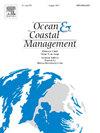Wave storm impacts on shoreline evolution: A case study of Iztuzu beach
IF 4.8
2区 环境科学与生态学
Q1 OCEANOGRAPHY
引用次数: 0
Abstract
This study investigates the evolution of the Iztuzu beach shoreline and its response to wave storm characteristics and frequencies. Firstly, using the Digital Shoreline Analysis System (DSAS) tool, high spatial resolution satellite imagery, coastal changes were assessed over various time scales covering the decade of 2013–2022. Secondly, considering the same timeframes, wave storm characteristics occurrence and characteristics of Iztuzu beach were assessed. Lastly, the coastal evolution and wave storm assessment results are linked based on correlation analysis to define the relation between the observed coastal changes and the wave storm frequency and characteristics changes. Thus, the present study's main advance lies in considering the impact of some key characteristics of wave storms, such as storm duration, direction and total energy, on shoreline evolution. The correlation analysis of shoreline changes and storm characteristics revealed the influence of wave storms on coastal dynamics. The study results highlight the significant sensitivity of certain beach zones to storm characteristics and point out the possibility of predicting future shoreline changes using projected wave storm patterns. Throughout the study period, Zones II, III, and IV experienced consistent erosion, likely attributable to the interaction between the southwest-oriented shoreline and the prevailing storm wave direction from the South. This alignment generates strong drift currents, contributing to the observed shoreline retreat. For instance, the correlation exceeded 0.8 at Zones III, IV, and V for wave storm duration, SPI and TSWE against the EPR, and 0.7 at the same zones for the same characteristics against the LRR. As a result, coastal erosions at Iztuzu Beach are more linked to the intensity and duration of southern wave storms. Thus, this study emphasizes the importance of combining wave storm data and shoreline analysis to develop effective coastal management and mitigation strategies.
波浪风暴对海岸线演变的影响:以Iztuzu海滩为例
本文研究了伊兹祖海滩岸线的演变及其对波浪风暴特征和频率的响应。首先,利用数字海岸线分析系统(DSAS)工具和高空间分辨率卫星图像,评估了2013-2022年10年间不同时间尺度的海岸变化。其次,在相同的时间框架下,对伊兹祖海滩的风浪特征发生和特征进行了评价。最后,通过相关分析将海岸演变与风浪评价结果联系起来,明确观测到的海岸变化与风浪频率和特征变化之间的关系。因此,本研究的主要进展在于考虑了风暴的一些关键特征,如风暴持续时间、方向和总能量对海岸线演变的影响。岸线变化与风暴特征的相关分析揭示了波浪风暴对海岸动力学的影响。研究结果强调了某些海滩地区对风暴特征的显著敏感性,并指出了利用预测的波浪风暴模式预测未来海岸线变化的可能性。在整个研究期间,II区、III区和IV区经历了持续的侵蚀,这可能是西南方向的海岸线与南方盛行的风暴波方向相互作用的结果。这种排列产生了强大的漂流流,造成了观测到的海岸线后退。例如,风暴潮持续时间、SPI和TSWE与EPR的相关性在III、IV和V区均超过0.8,相同特征与LRR的相关性在相同区域均超过0.7。因此,伊兹图祖海滩的海岸侵蚀更多地与南部海浪风暴的强度和持续时间有关。因此,本研究强调将波浪风暴数据与海岸线分析相结合对于制定有效的海岸管理和减灾战略的重要性。
本文章由计算机程序翻译,如有差异,请以英文原文为准。
求助全文
约1分钟内获得全文
求助全文
来源期刊

Ocean & Coastal Management
环境科学-海洋学
CiteScore
8.50
自引率
15.20%
发文量
321
审稿时长
60 days
期刊介绍:
Ocean & Coastal Management is the leading international journal dedicated to the study of all aspects of ocean and coastal management from the global to local levels.
We publish rigorously peer-reviewed manuscripts from all disciplines, and inter-/trans-disciplinary and co-designed research, but all submissions must make clear the relevance to management and/or governance issues relevant to the sustainable development and conservation of oceans and coasts.
Comparative studies (from sub-national to trans-national cases, and other management / policy arenas) are encouraged, as are studies that critically assess current management practices and governance approaches. Submissions involving robust analysis, development of theory, and improvement of management practice are especially welcome.
 求助内容:
求助内容: 应助结果提醒方式:
应助结果提醒方式:


